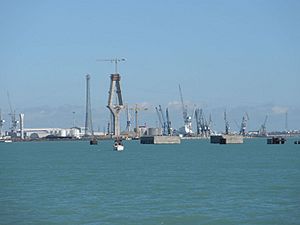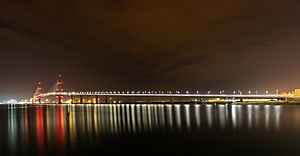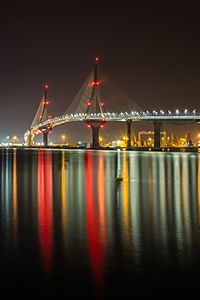La Constitución de 1812 Bridge facts for kids
Quick facts for kids Constitution of 1812 Bridge |
|
|---|---|

View of the bridge, in August 2015.
|
|
| Coordinates | 36°31′29″N 6°15′25″W / 36.52472°N 6.25694°W |
| Carries | 6 lanes (2 lanes each way, and 2 tram ways) |
| Crosses | Bay of Cadiz |
| Locale | Cadiz and Puerto Real, |
| Official name | Constitution of 1812 Bridge |
| Characteristics | |
| Design | Cable-stayed bridge by Javier Manterola |
| Total length | 3,092 meters (10,144 ft) |
| Width | 34.3 meters (113 ft) |
| Longest span | 540 meters (1,770 ft) |
| History | |
| Opened | 24 September 2015 |
| Statistics | |
| Daily traffic | expected 20,000 AADT |
The Constitution of 1812 Bridge, also known as La Pepa Bridge, is a modern bridge in Spain. It crosses the Bay of Cadiz. This bridge connects the city of Cadiz with Puerto Real on the mainland.
Cadiz already had a bridge called the Carranza Bridge, built in 1969. About 40,000 vehicles use it every day. Because of this heavy traffic, the Spanish government decided in 1982 that a second bridge was needed.
The Constitution of 1812 Bridge has two tall towers, called pylons, that are 180 meters high. One pylon stands in the sea, and the other is in Cabezuelas Harbour. The main part of the bridge, called the main span, stretches 540 meters. Ships can pass underneath because there is 69 meters of space below the bridge.
This bridge is the second one to connect Cadiz to the mainland. It is also one of the tallest bridges in Europe. It stands 69 meters above the water and is about 5 kilometers long in total. The bridge has a wide deck, which means it can handle a lot of traffic. It has two lanes for cars in each direction. It also has two special lanes for public transport, like the Cádiz Bay tram-train.
The bridge was designed by a civil engineer named Javier Manterola. The plan was to finish building it in 2012. This year marked 200 years since the Spanish Constitution of 1812 was created in Cadiz. However, due to money problems during an economic crisis, the bridge was finished more than three years late.
By the summer of 2013, construction was moving slowly. But in early 2014, work sped up. More workers were hired, and they even worked night shifts. By mid-2015, the main structure of the bridge was complete. The entire bridge was finished in September of that year.
Here are some interesting facts about the bridge:
- The first design for the bridge was for an arch bridge. It would have been 2.355 kilometers long.
- The current bridge, including its connecting roads, is 5 kilometers long. About 3,096 meters of this is the bridge itself. Of that, 1,655 meters are over the sea.
- Its main span of 540 meters is the longest in Spain. It is 100 meters longer than the bridge over the Barrios de Luna reservoir.
- The main span is also the third largest of its kind in Europe. Only the Rio-Antirio Bridge and the Normandy Bridge are longer.
- The bridge reaches a maximum height of 69 meters above sea level. Its two pylons are 187 meters tall. This makes it one of the tallest bridges in Europe.
- These pylons are 30 meters taller than the pylons that used to stand on both sides of the bay.
The bridge connects the San Pedro River area in Puerto Real with the La Paz neighborhood in Cadiz.
Contents
Building the Bridge: The Plan
The idea for a new bridge over the Bay to access Cadiz started with studies in 2003. These studies looked at earlier plans from 1989. The main goal was to fix the traffic jams. These jams happened when people tried to get into Cadiz from Puerto Real using the old Carranza Bridge and the CA-33 road.
The plan considered different ways to link the N-443 road to Cadiz. Engineers looked at three main options for the bridge's path across the bay. These options aimed to connect different parts of the mainland to Cadiz.
For crossing the bay, the first ideas included building a tunnel underwater. However, a large, fixed bridge was also considered. This was because a bridge could cross the main shipping channel in a straight line. This would allow for wide openings for ships to pass. Engineers studied different types of bridges: arch, cable-stayed, and suspension bridges.
The option with the bridge structure was chosen as the best solution. It was good for city traffic on both sides of the bay. It also cost the least money and fit well with the city's design and the natural landscape.
Out of the different bridge types, the cable-stayed design was picked. It was the most affordable and had a simpler structure.
How the Work Was Done
The construction of the bridge was handled by a joint team. This team was made up of two companies: Dragados and DRACE. The project cost 273 million euros. It was expected to take about 42 months to build.
At its busiest times, the construction project employed about 500 people directly.
Bridge Features
The bridge is designed like a highway. Cars can drive up to 80 kilometers per hour on it. This speed limit is set because the bridge is part of a city area.
The bridge is 4,580 meters long in total. Here are some lengths of its parts over the sea:
- Access to Cadiz: 25 meters by 7 meters; 75 meters.
- Removable section: 150 meters.
- Access to Puerto Real: 850 meters.
The cable-stayed part of the bridge is the highest section. It has a maximum slope of 5%. On land, the bridge is built over the industrial area of La Cabezuela. This helps to improve the existing road system.
The bridge has three lanes in each direction for vehicles. There is a strong barrier in the middle, 0.8 meters wide. On the sides, there are sidewalks that are 1.30 meters wide. The total width of the bridge is 30.5 meters. However, where the cables are attached, the bridge widens to 32.5 meters to hold the suspension struts.
Bridge Supports
The bridge has 39 support points. These include 37 main supports (batteries) and 2 end supports (stirrups). Twelve of these supports are in the sea. All of them are built using piles, which are like large columns, 2 meters wide. These piles are driven deep into the ground below the sea.
Cadiz End Support
The bridge starts with a road that leads directly to and from the new bridge. This road connects to a roundabout in Cadiz. This helps keep traffic flowing smoothly in the city.
Cadiz Access Section
This part of the bridge is 581.2 meters long. It has a mixed structure, meaning it uses different materials. The main supports for this section are 75 meters apart. These supports are held up by pylons. The pylons go 30 meters deep into the ground and have 4 to 6 piles each.
See also
 In Spanish: Puente de la Constitución de 1812 para niños
In Spanish: Puente de la Constitución de 1812 para niños






